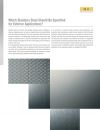Corrosion or rust staining can be caused by coastal or deicing salts, atmospheric contaminants, inappropriate cleaning products, and superficial carbon steel or iron contamination.The mild abrasive products that are used for removing adherent or hardened deposits will remove most light to moderate rust staining.
Light staining can often be removed by the standard cleaning products used to remove dust and fingerprints from surfaces. Try one of these first before using more aggressive cleaning products.
In some parts of the world, you can obtain mild abrasive (200 mesh or finer calcium carbonate) household cleaners that contain dilute acids that are very effective in dissolving rust stains. The acids that are often used for this purpose are citric acid, nitric acid, phosphoric acid, and oxalic acid. Do not use any product that contains hydrochloric acid for this purpose because it can cause surface corrosion. The potential environmental impact of using acid must be assessed before use. They are the products that are most typically used for restoring neglected stainless steel building exteriors and are usually sufficient.
There are also commercial rust removal products that are specifically designed for use on stainless steel. Do not use a general “rust removal” product without identifying its ingredients and determining if they are acceptable for use on stainless steel. Test any new product on a small stainless steel surface prior to use to make sure that it does not cause color change.Follow manufacturers instructions for application and surface rinsing.These products typically contain phosphoric, nitric, citric, or oxalic acid.Determine the potential environmental impact before use.For example, the concentrations of nitric acid that are used may over-fertilize and kill nearby plants. Spray gels that allow controlled application and longer dwell times should be used instead of liquids.Some manufacturers have neutralizers that can be spray on top of the gel while it is in place to reduce the environmental impact.
If corrosion staining is removed but returns rapidly (within a few days or weeks), it is likely that the surface has been contaminated with heavily embedded carbon steel or iron. These generally have to be removed by grinding and refinishing and/or by pickling.
If welds have not been properly cleaned and heat tint was left on the surface, the welds will need to be ground and/or pickled to restore corrosion resistance. Information on restoring the corrosion resistance of a weld can be obtained from welding product suppliers or on the following website: www.stainlessarchitecture.org.


